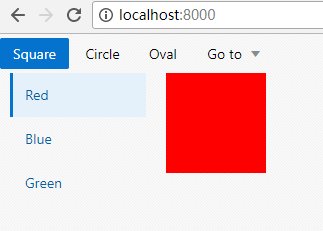单页面应用程序:使用一个进加载一次的网页,如果页面由于用户的交互而改变,则仅绘制更改的页面部分。
要创建单页面应用程序需要使用 oj.Router 的虚拟导航来支持,ojModule 用来响应页面的重新绘制。 ojModule 仅用于分离的 view 和 viewMode ,使之与页面通过 Knockout绑定。另外,ojModule 可选,当不使用分离视图与模型时,可直接在元素上响应变化。
1.简单模型:

当选择 Chapter1 或其他时,将显示新内容,并且URL更改以反映用户在页面上当前的位置。

2.路由器适配器
路由器带有两个URL适配器。每个适配器定义如何将URL格式化表示。
urlPathAdapter:在路径段中格式化 URL 。每个段都是的当前状态 id ,由 ‘ / ’ 分隔,如: localhost:8000/chap1
urlParamAdapter:使用查询参数格式化 URL 。每个参数都是路由器名称及其当前状态 id ,如:localhost:8000/?root=chap1
路由器的默认适配器是 urlPathAdapter 。需要更改可以使用 方法:
oj.Router.defaults['urlAdapter'] = new oj.Router.urlParamAdapter
当路由单页应用程序时,页面不会从头开始加载,但页面内容会动态更改。为了成为浏览器历史的一部分并提供书签内容,Oracle JET 路由器模拟使用 HTML5 历史记录推送状态功能导航的行为。路由器还控制 URL 看起来像传统页面 URL。 这些 URL 没有资源,必须设置 HTML 服务器。这是通过一个重写引擎的简单规则完成的。
一般来说,当应用程序中用户需求只包含几个视图并且关联状态不是很复杂,则使用查询参数。而路径段显示 URL 则显得 URL 更简洁,特别是使用嵌套路径(添加子路由)。
ojModule 与 oj.Router 结合使用,可以配置 ojModule 对象,其中模块名称是路由器的状态。当路由器更改状态时,ojModule 将自动加载并呈现当前 RouterState 对象的值得指定模块内容。
3.简单使用例子:
(1)appController.js:
define(['ojs/ojcore', 'knockout', 'ojs/ojknockout', 'ojs/ojrouter', 'ojs/ojbutton', 'ojs/ojtoolbar'],
function(oj, ko) {
function ControllerViewModel() {
var self = this;
self.router = oj.Router.rootInstance;
self.router.configure({
'pref': { label: 'Preface', isDefault: true},
'chap1': { label: 'Chapter 1'},
'chap2': { label: 'Chapter 2'},
'chap3' : {label: 'Chapter 3'}
});
oj.Router.defaults['urlAdapter'] = new oj.Router.urlParamAdapter;
}
return new ControllerViewModel();
}
);
a)添加 ojrouter 模块。
'ojs/ojrouter'
b)创建路由实例,oj.Router.rootInstance 表示唯一根路由,该路由的名称是 “root” 。
self.router = oj.Router.rootInstance;
c)配置路由器状态,属性: label:链接字符串,没有定义标题属性时,用于页面的标题。
value:与该状态相关联的对象。
isDefault:设置起始页面
self.router.configure({
'pref': { label: 'Preface', isDefault: true},
'chap1': { label: 'Chapter 1'},
'chap2': { label: 'Chapter 2'},
'chap3' : {label: 'Chapter 3'}
});
d)URL适配器,可选。
oj.Router.defaults['urlAdapter'] = new oj.Router.urlParamAdapter;
(2)main.js
require(['ojs/ojcore', 'knockout', 'appController', 'ojs/ojknockout', 'ojs/ojrouter', 'ojs/ojmodule'], function (oj, ko, app) { $(function() { oj.Router.sync().then( function() { ko.applyBindings(app, document.getElementById('routingContainer')); }, function(error) { oj.Logger.error('Error in root start: ' + error.message); } ); }); } );
a)添加 ojrouter 模块和 ojmodule(需要使用 ojmodule 时添加)
'ojs/ojrouter', 'ojs/ojmodule'
b)将路由器与当前 URL 同步。必须在路由器配置后才能调用,以将 URL 与路由器状态同步。
oj.Router.sync().then()
c)将 appController 挂载到 HTML 上
ko.applyBindings(app, document.getElementById('routingContainer'))
(3)index.html
<div id="routing-container">
<div id='buttons-container' data-bind="ojComponent: {component:'ojToolbar'}">
<div data-bind="ojComponent: { component: 'ojButtonset',
checked: router.stateId,
focusManagement: 'none'}">
<!-- ko foreach: router.states -->
<label data-bind="attr: {for : id}"></label>
<input type="radio" name="chapter" data-bind="value: id,
attr: { id: id},
ojComponent: { component: 'ojButton',
label: label}"/>
<!-- /ko -->
</div>
</div>
<div data-bind="ojModule: router.moduleConfig"></div>
</div>
a)选择时触发状态转换
定义 checked 属性给予 router.stateId 观察值。它使用双向绑定。当点击一个按钮时,id 被写入到 stateId 中,使路由器状态转换。
b)观察状态并更新相关部分
data-bind="ojModule: router.moduleConfig"
使用需要创建相应的 views 和 viewModels

c) router.states 可以获取到路由配置转化的数组以供遍历展示内容
(4)实际效果如前简单模型相同。
4.使用子路由
(1)appController.js
define(['ojs/ojcore', 'knockout', 'ojs/ojknockout', 'ojs/ojrouter', 'ojs/ojbutton', 'ojs/ojtoolbar', 'ojs/ojnavigationlist'], function(oj, ko) { function ControllerViewModel() { var self = this; // 创建根路由 self.shapeRouter = oj.Router.rootInstance; self.shapeRouter.configure({ 'square': { label: 'Square', isDefault: true }, 'circle': { label: 'Circle' }, 'oval': { label: 'Oval'} }); // 创建子路由配置 self.colorRouter = self.shapeRouter.createChildRouter('color').configure({ 'red': { label: 'Red', isDefault: true }, 'blue': { label: 'Blue' }, 'green': {label: 'Green'} }); self.menuItemSelect = function(event, ui) { self.shapeRouter.go(ui.item.children('a').text()); } } return new ControllerViewModel(); } );
a)创建根路由
b)创建子路由并配置
使用 createChildRouter('name') 创建子路由并添加 configure 配置。
(function(event, ui) 这里的 event, ui 是 select 带有的属性。另外 optionhange 等也有这两属性)
(2)main.js 与上例相同
(3)index.html
<div id="routing-container"> <!-- 导航栏部分 --> <div id="toolbar" data-bind="ojComponent: { component: 'ojToolbar'}"> <!-- 父路由导航栏部分 --> <div data-bind="ojComponent: { component: 'ojButtonset', checked: shapeRouter.stateId, focusManagement: 'none' }"> <!-- ko foreach: shapeRouter.states --> <label data-bind="attr: {for: id}"></label> <input type="radio" name="shape" data-bind="value: id, attr: { id: id}, ojComponent: {component: 'ojButton', label: label}"></input> <!-- /ko --> </div> <!-- 直接跳转指定位置 --> <button id="menuButton" data-bind="ojComponent: { component: 'ojButton', label: 'Go to', menu: '#gotoMenu'}"> </button> <!-- 列表显示跳转位置 --> <ul id="gotoMenu" style="display: none" data-bind="ojComponent: { component: 'ojMenu', select: menuItemSelect }"> <!-- ko foreach: shapeRouter.states --> <li> <a data-bind="text: label"></a> <ul data-bind="foreach: $root.colorRouter.states"> <li> <a data-bind="text: '/' + $parent.id + '/' + id"></a> </li> </ul> </li> <!-- /ko --> </ul> </div> <hr/> <!-- 展示部分 --> <div id="pageContent" class="oj-flex oj-flex-items-pad"> <!-- 子路由导航栏 --> <div class="oj-xl-2 oj-lg-2 oj-md-2 oj-sm-12 oj-flex-item"> <div id="colors" data-bind="ojComponent: { component: 'ojNavigationList', selection: colorRouter.stateId, drillMode: 'none'}"> <ul data-bind="foreach: colorRouter.states"> <li data-bind="attr: {id: id}"> <a data-bind="text: label"></a> </li> </ul> </div> </div> <!-- 图形显示 --> <div class="oj-xl-10 oj-md-10 oj-sm-12 oj-flex-item"> <div data-bind="css: shapeRouter.stateId(), style: { background: colorRouter.stateId() }"></div> </div> </div> </div>
a)stateId 可以让 knockout 观察,而 steteId() 则可以读取当前的 Id 的值。
(4)CSS
.square { width: 100px; height: 100px; } .circle { width: 100px; height: 100px; -moz-border-radius: 50px; -webkit-border-radius: 50px; border-radius: 50px; } .oval { width: 200px; height: 100px; -moz-border-radius: 100px / 50px; -webkit-border-radius: 100px / 50px; border-radius: 100px / 50px; }
(5)效果显示:


